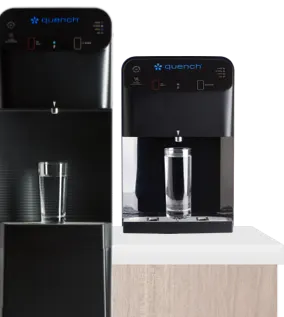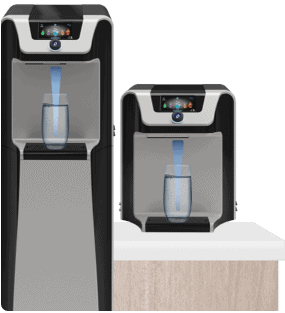Water covers 70% of our planet, so it’s easy to assume that there’s enough to go around. Unfortunately, that’s not the case. According to National Geographic, less than 3% of the world’s water resources are freshwater, and of that already minuscule percentage, only 1.2% can be used as drinking water — not to mention sources of fresh drinking water are becoming increasingly scarce.
With a growing concern for worldwide water stress, read on to learn everything you need to know about water shortages and their repercussions — along with strategies to boost your workplace water sustainability efforts moving forward.
Looking at Water Scarcity and Its Consequences
Water scarcity — a concept closely related to water stress or water crisis — refers to the lack of water resources that can be accessed to sufficiently meet water demand. According to the UN, 2.3 billion people live in water-stressed countries across the globe. Water scarcity falls into two categories: physical water scarcity and economic water scarcity.
- Physical water scarcity: This type of water shortage occurs when the demand of the population exceeds the water resources that are available in the region. Characterized by the growing climate crisis and declining groundwater levels, physical scarcity typically emerges in dry, arid areas around the world.
- Economic water scarcity: Economic scarcity, on the other hand, arises when there’s enough potable water for the region but is unavailable due to insufficient investment in water infrastructure. Communities that lack the structures and systems to supply and distribute water equitably are particularly vulnerable to fluctuations in weather that lead to floods and drought conditions.
What Causes Water Scarcity?
This issue of water stress is becoming a major issue on every continent, with impoverished regions and communities ultimately being hit the hardest. But what exactly is behind the growing water crisis? Unfortunately, there isn’t one simple underlying cause to address. Water can become scarce for several reasons:
- Agriculture: The agricultural sector consumes more water than any other source, accounting for 72% of all water withdrawals, per a report from the UN. Not only is this a tremendous amount of water use, but much of it’s also wasted in the process due to inefficiencies (i.e., poor irrigation systems and water management).
- Insufficient infrastructure: As mentioned before, regions that don’t have the proper systems in place to access and distribute clean water can quickly run into scarcity challenges.
- Climate change: Much of the accelerated water stress experienced across the world is linked to climate change. This is because changing weather and global water patterns are leading to shortages and drought conditions in some areas and floods in others.
- High water demand: A water crisis can be the simple result of demand exceeding the water supply in the area. Research from Morgan Stanley’s Sustainability Research Team finds that the gap between global demand and supplies of fresh water is expected to reach 40% by 2030.
- Disproportionate distribution: Challenges with water stress can also be a result of institutions and municipalities failing to balance everyone’s needs. While secure water access is a fundamental right, water inequality continues to grow — where imbalances are intensified by rapid urbanization.
- Groundwater depletion: Sustained groundwater pumping can lead to long-term declines in the water level of a certain region. This has several negative effects to consider including the deterioration of water quality and a reduction of water in streams and lakes.
The Impact of Water Shortages
A lack of sufficient water resources will inevitably lead to a detrimental aftermath. Some of the major potential ramifications to take into account include:
- Limited access to safe water for drinking and practicing basic hygiene.
- Sewage system failures, which lead to surges of preventable diseases like cholera.
- Increased competition between water users, driving the threat of conflict.
- Impeded economic growth.
- Restricted production of water-intensive goods (e.g., food, clothing, and cars).
- The subsequent destruction of environmental habitats.
The 6 States Running Out of Water
The areas where water resource scarcity is most severe are the Middle East and North Africa — hosting 6.3% of the world’s population and containing only 1.4% of the planet’s renewable drinking water, reports the Population Reference Bureau. However, while shortages are acute in developing countries, this isn’t solely an issue for emerging nations. Americans are facing barriers that impede access to sufficient, safe, and accessible potable water and water resources as well.
The World Economic Forum reports that as many as 2.2 million people across the nation are without running water and basic indoor plumbing, with 44 million individuals only being able to access inadequate water systems. What’s more, water scarcity news stories in the U.S. of record temperatures, raging wildfires, and water restrictions due to drought have been running rampant in recent years. And some states continue to be hit harder than others.
Let’s take a closer look at the states most impacted by drought and water shortages.
1. Colorado
The Colorado River Basin and its two reservoirs, Lake Powell and Lake Mead, have hit historic lows in the past few years. This drying up is due to a combination of chronic overuse of water resources and unprecedented drought. As a result, exceptional drought conditions in Colorado have now been an issue for more than two decades. Water shortages from severe drought in this region are only augmented by excessive water usage from farmers.
2. California
According to the U.S. Drought Monitor, extreme drought conditions in California have improved in recent years, but the entirety of the state continues to remain under some level of aridness — with 33% of the state designated as being in severe drought. Experts explain that this isn’t a result of low precipitation but rather rising temperatures, groundwater depletion, and a diminishing Colorado River.
As these weather challenges and water shortages continue, it’s likely this region will face consequences that include dried-up farmland, crop shortages, increased fire danger, dying trees, and forced compliance with water restriction ordinances.
3. Nevada
Considering this state is well known for its desert and semiarid climate, it might not come as too much of a surprise that Nevada is also navigating scarcity challenges and continued droughts. In addition to climate change and a lack of snowpack storage, this is mainly attributed to the decreasing water levels of Lake Mead.
Depending on how water levels in Colorado look over the coming years, Nevada is projected to take water shortage reductions this year and for the foreseeable future. This includes bans on swimming pools, grass watering, and irrigation in an attempt to save its vanishing water supply.
4. New Mexico
In this drought-ridden state, concerns about water supply are principal. This is particularly true for the northern and southeastern parts of the state where conditions are more extreme. Individuals living in this area are probably used to the long periods of drought, but an unusually light snowpack, inconsistent precipitation, and reliance on surface water are quickly adding to the strain on water resources.
5. Utah
Utah, an Upper Basin state, has been no stranger to extreme drought over the years. Severe weather is highly prevalent in the southern and central portions of the region. Circumstances here are an outcome of a swiftly melting snowpack, higher-than-usual temperatures, and a lack of precipitation — on top of the drying out of Lake Powell. Fortunately, while not out of the water shortage woods yet, the extremely dry conditions in Utah are improving.
6. Arizona
The drying of the Colorado River has also critically impacted water supplies in Arizona. As water usage has become partially restricted in this section of the country, the state has become increasingly reliant on groundwater pumping — providing 41% of the region’s water needs, according to Time. This may eventually prove problematic as groundwater depletion leads to dried-up wells, lower levels of water in streams and lakes, and water quality deterioration.
As demand continues to increase, Harvard reports that several U.S. regions could see water supplies reduced by a third of their current size as soon as 50 years from now. This will only supplement the challenges that vulnerable states are navigating today.
Understanding Drought Stages and Water Restrictions
For organizations located in a state that’s impacted by drought, it can quickly become confusing to understand what’s expected of you in terms of response actions. Here’s a quick guide to recognizing the severity of your state’s circumstances and what you can do about it:
- None: This stage represents normal conditions, consisting of ongoing water conservation and the enforcement of water waste prohibition. At this point, public outreach to educate individuals is the best way to maintain stronger conditions.
- Stage 1: In this water alert stage, there’s a 15% water supply reduction. Acknowledged as the beginning stage of drought, voluntary conservation measures should be encouraged to achieve demand reduction.
- Stage 2: At this point, organizations and individuals alike can anticipate moderately restricted water supplies up to 30%. Titled a water warning, this stage is characterized by growing public awareness and mandatory water conservation measures (e.g., watering limitations).
- Stage 3: Officially considered a water crisis, stage three of drought will lead to severe constraints of 50% of water resources available. In addition to mandates for confining water usage, water rationing can also be expected.
- Stage 4: The last stage of drought is considered a water emergency which involves extreme water restrictions (greater than 50%) and water rationing for health and safety purposes.
Alleviating Water Stress and Promoting Sustainability at Work
UNICEF reports that 1.42 billion people today, including 450 million children, live in areas of high or extremely high water vulnerability. That’s almost a sixth of the entire planet. This highlights the crucial need for everyone to do their part to minimize the water crisis at hand — and your workplace is no exception. Organizations today need water solutions that not only ensure employees, guests, and customers can access clean water as needed, but also encourage long-term sustainability.
With this in mind, it’s critical to note that if your team relies on bottled water sources and recurring delivery, this is likely doing a lot more harm to the environment than you might realize. Some of these environmental costs include plastic waste and hefty CO2 emissions from delivery trucks. But, in terms of water scarcity, these traditional systems are also inefficient and wasteful: It takes two to five-gallon jugs of water to manufacture a plastic jug — including all of the process steps to extract the petroleum, make the plastic, and form the bottle.
Instead, your workplace can offer clean water and boost sustainability by introducing a bottleless water cooler from Quench®. We offer water-as-a-service solutions by providing filtered water through a broad array of bottleless machines to help you keep your workforce and customers happy, healthy, and hydrated at all times.
Inspired by innovation and environmental conscience, a bottleless water dispenser from Quench leverages cutting-edge filtration technology to deliver great-tasting, clean water safely and sustainably. That’s why our products are made in an ISO-certified factory, operating at high efficiency to minimize waste and the environmental impact of our water solutions.
Water scarcity and shortages are growing causes for concern nationwide, but a bottleless dispenser can help your workplace take sustainable steps in the right direction. Ready to get started? Get a free quote today.











